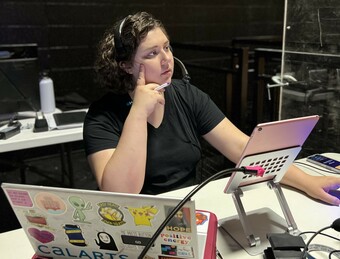The Ambition to Pay Actors
Can LA Afford to Make a 99-seat Compromise?
This post is from a series about Los Angeles theater, the values we apply to our art and business choices, and about how we collectively address challenges and the need for change. These posts reference a Call for Action published on 9/24/14.
I live in Portland, Oregon and am the artistic director of Artists Repertory Theatre. Ours is a mid-size organization, and we produce an eight-play season in two intimate performance spaces of 224 and 164 seats. We operate under Actors Equity’s Small Professional Theater Contract-8, which pays actors roughly $525/week, plus pension and healthcare for up to thirty-eight hours of rehearsal and up to seven performances per week. I feel very lucky to be doing what I’m doing. In many ways, I owe my good fortune to the fourteen years I spent making theater in LA’s complex, vibrant and excellent theater scene.
In 1999, I arrived in LA in a Ryder truck with the contents of several friends’ apartments and the unit set for a play we had just successfully produced together in Chicago. We remounted our play—largely unnoticed by audiences or press—in a fifty-seat space on theater row that never saw a sold out crowd. We were all in our early twenties. I don’t recall our non-Equity cast of six (which included me) ever discussing the possibility of getting paid. Though we never described our venture as such, this was meant as a showcase. We held the naïve notion that producing one play in Hollywood would be an entry to the film industry. We closed our play painfully disillusioned, and declared—over many drinks—that Los Angeles was a hostile environment for theater.
Despite our youthful and crude expectations, I believe we were, and have since proven to be, authentic theater artists. After a couple of years spent acclimating to the realities of LA, we reorganized and established our group in 2001 as a nonprofit organization called Furious Theatre, with the hopes of launching a professional theater company. We acquired a temporary—but free—warehouse space in Pasadena and decided to produce at least three plays per year. The six founders donated $2500 each and agreed to do so for three years, but determined to pay guest artists to the best of our abilities. Because of a once-in-a-lifetime corporate matching grant, we found ourselves with $45k to launch our inaugural season. We had heard much about the Actor’s Equity Association (AEA) 99-Seat Plan which allowed us to cast union actors at a per performance stipend of seven dollars, and without rehearsal pay, but hoped to produce on some version of a developmental tiered contract—perhaps something similar to AEA’s Chicago Area Theater Contract which utilizes a system of tiers, the entry tier starting at well under $200/week, but with restricted rehearsal hours. We wanted to hire professionals more experienced than us, from whom we might learn and who would elevate our fledgling organization. We proposed that operating on an AEA contract would attract talent and possibly make the press take special note of our company. So, I called Equity with the assumption that we would utilize an existing tiered contract for startup companies in LA.
I vividly remember my phone call. I was told the 99-Seat Plan was my only viable option. I said the seven dollars per performance and zero dollar rehearsal pay required was less than we were able to pay. I suggested that getting on a contract would “train” our new organization to pay artists. I was informed that no such developmental option existed and that we should simply use the Plan. The AEA contract representative admired our intentions, but at the time the only contract available would require several hundred dollars per week per actor. It was too much for us. Of course, nothing would prevent us from paying more than the required minimum. So we proceeded.
We paid more than the required seven dollars per performance—our casts made eleven dollars per performance that year—and over subsequent years, we arrived at a rate of twenty-five dollars per performance, along with a rehearsal stipend of $300-400. In our fourth year, we hit a milestone: the founders were no longer making their $2500 annual donation—which felt like being paid. In year seven, we went back to AEA and negotiated a contract, a special Letter of Agreement contract that the union had begun to test, since a handful of companies had shown interest in a modest contract. We no longer operated under the 99-Seat Plan, though our theater at the Pasadena Playhouse held only eighty-seven seats. Actors were paid roughly minimum wage for rehearsals, and forty-four dollars per performance during the run, along with 8% pension. Health insurance payments, which would double our costs, were waived, and a feeling of respect and professionalism was palpable. There was a great challenge and compromise, however: under this contract we could only afford twenty hours per week of rehearsal (the minimum allowed on the LOA contract). Producing the same productions under the 99-Seat Plan would require only one-third of what we were then paying per performance, while allowing up to thirty-six uncompensated weekly hours in the rehearsal room. Our process was compromised by our ambition to pay actors.
When I arrived in Portland, I was surprised to learn that there was no comparable plan for hiring AEA actors without rehearsal pay. I rarely hear theaters defined by the number of seats. I know of many AEA members who have been cast in low-budget productions produced by fledgling companies in less than 100-seat theaters. The salary? Just over $200 per week with limited rehearsal hours—very modest, but greatly appreciated by the actors, who acknowledge that producers are stretching themselves in order to afford union talent. I’ve been impressed by the size of the theater scene here, and the ambition of the approximately eighty local companies to pay all artists. It may (or may not) be a coincidence that the local funding community is vastly more supportive of theaters than what I experienced in LA. And it’s not that more tickets are being sold in Portland helping to pay artists; rather the greater costs require smaller companies or one-off producers to secure additional funding before they are ready to commit to producing
Professional theatermakers are tenacious and undeniable. If similar contracts to what I’ve described were the reality in LA, great companies would rise to it. Productions would certainly require more planning and more fundraising—more non-profit 99-Seat theater companies would need to establish proper boards of directors—but great theater in 99-seat spaces would continue. Perhaps there would be fewer productions, but I’m not convinced that would be the case. And a more respectful minimum or developmental AEA contract wouldn’t prevent wave after regenerative wave of young, non-Equity talent from banding together and making work.











Comments
The article is just the start of the conversation—we want to know what you think about this subject, too! HowlRound is a space for knowledge-sharing, and we welcome spirited, thoughtful, and on-topic dialogue. Find our full comments policy here
Thank you so much for this article. As a new AEA member, I find the process difficult to deal with, I don't feel Equity makes it as simple as they claim, A production wanted to hire me and had to jump through hoops in order to do so, so much that they stated they will never hire another AEA member again because it was too stressful and they didn't know if they could give me enough rehearsal time although willing to pay me WAY more than the AEA under 50 contract. It was awful because I want to work, cause little disturbance to the producers, and hopefully get a bit of money for my services to survive. There has to be better alternatives and speedier resolve on the Unions part. I went in and filed a complaint.
Damasco, does Furious Theatre sitll exist? If so, why aren't you there anymore?
This is a great summary of the problems, pragmatics and possibilities for change in LA, where there is no adequately tiered model for growth out of the 99 seat option. I asked an AEA rep once... how money theatres, in all those decades of waiver agreements, ever moved into larger spaces. He said... 3... maybe 4. This was about 10 years ago, but the waiver scene was about thirty years old then. I don't thing it's changed much in the last decade. It's funny... as a parallel to your experience... at San Diego Rep, it also took us about 7 or 8 years to grow into a Letter of Agreement. That was our goal from the beginning. We never looked seriously at any space with less than 200 seats. I think it's very hard to make any numbers work on behalf of actors with less than 150 seats. It's amazing what you did with 99 seats. That only happens if the producers are genuinely committed to serving actors. Thank you for a great little article.
When you say "more non-profit 99-Seat theater companies would need to establish proper boards of directors," are you not saying that small indy theatre should be even more limited to the wealthy and their children than it currently is?
No, I don't think that's what he's saying. In my experience, to serve underserved audiences you need an extremely diverse, dedicated and skilled board to take a stab at something most theatres never seriously attempt, whether it's paying actors, or serving the underserved. A proper board of directors is not made up of simply wealthy people dedicated to serving other wealthy people. A proper board understands the goals, will work to serve them, and will have the diversity to get the whole community involved. However, it's an interesting phrase... a proper board... something out of Gilbert and Sullivan? I suggest that a properly designed board would be more to the point. There are no cookie cutter answers to that, even though theatres tends to reinvent the formulas of The Organization Man (a sociological study from the 1950s about cookie cutter behaviors in large bureaucracies.) The business world strives more and more to move toward principles of creativity, while the arts world tends to fall into a dangerous tendency to build bureaucracies full of administrators with no resident artists.
Thanks for the thoughtful reply DW. I appreciate the need for the (very model of a) well-designed board— especially, as you say, to serve underserved audiences, an imperative that Dámaso doesn't address directly in his article. Rodriquez seems to be writing more simply about the need for a board to raise funds in order to meet a certain Equity contract threshold. I may be naive (scratch that, it's for sure!) but I do crave ways to think of our work as more artist-driven than paid for by a group of outside supporters, no matter how carefully cultivated. My NYC perspective is that successful startups almost always have connections to deep pockets, and I would love to see other roads evolve.